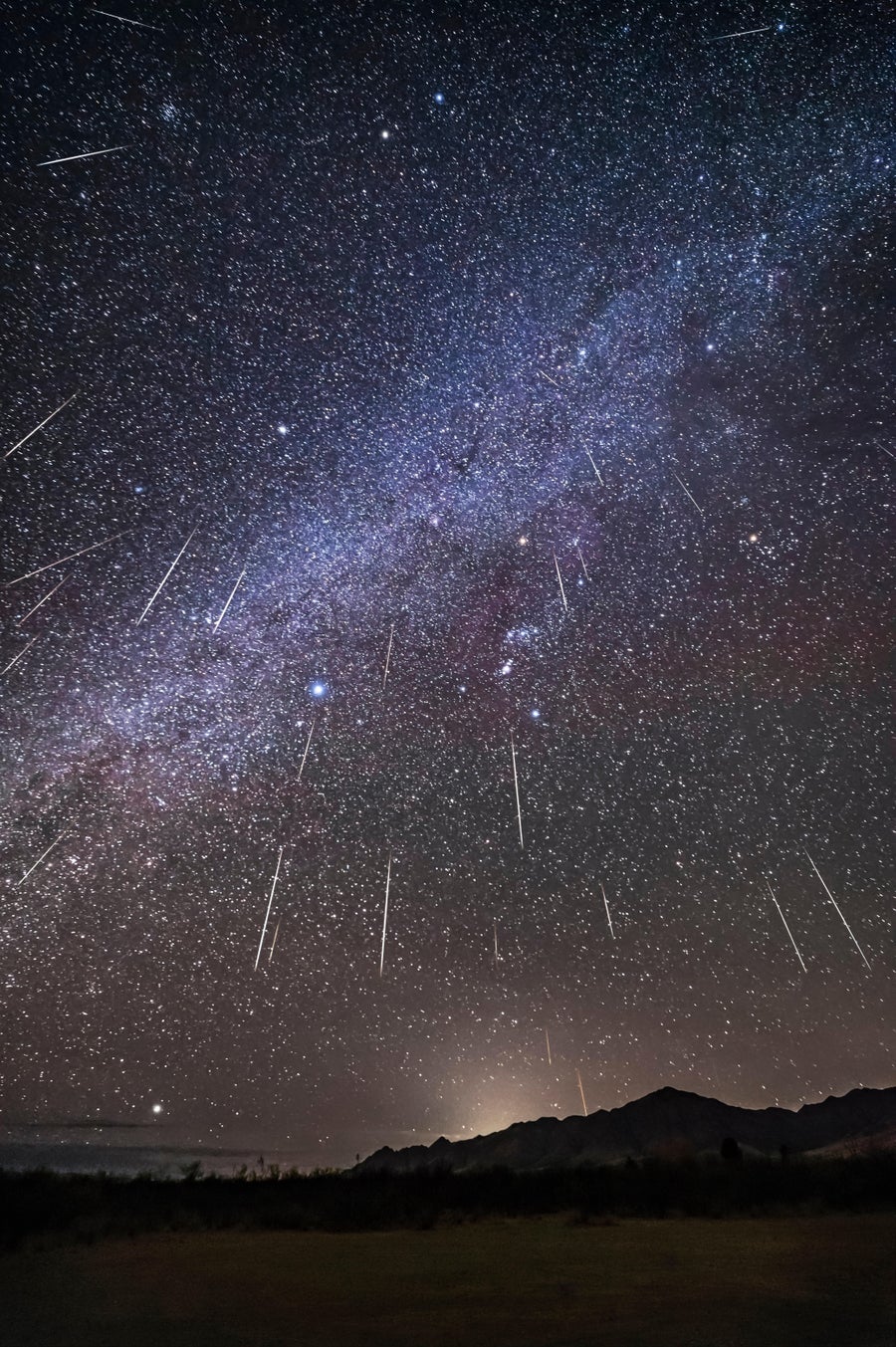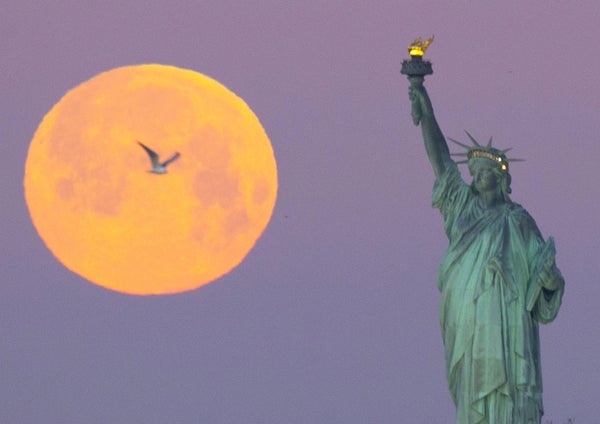With 2023 finally wrapped—and with some very interesting and beautiful cosmic images to show for it—it’s time to look ahead. What astronomical events does 2024 hold for us? There’s a whole year’s worth of sky phenomena to observe, so here’s your chance to learn more about and plan for some of them.
If you’re not familiar with the sky and aren’t sure where to look for these events, there are many planetarium apps you can download—a quick look on your favorite search engine should give you many choices. There’s also the free, browser-driven website Stellarium, which will show you a map of the sky for your location at a given time.
January 2/3: Earth at Perihelion
On supporting science journalism
If you're enjoying this article, consider supporting our award-winning journalism by subscribing. By purchasing a subscription you are helping to ensure the future of impactful stories about the discoveries and ideas shaping our world today.
Not to start off with a bummer, but we’ve already passed the first event of the year: earlier this week, Earth reached perihelion, the closest point to the sun in its annual elliptical orbit. That milestone occurred on January 3 at 12:38 A.M. UTC (January 2 at 7:38 P.M. EST), when Earth was slightly more than 147 million kilometers from our star. For the next six months or so, our planet will slowly move away from the sun, reaching its most distant point—aphelion—on July 5. You may be surprised to learn this has very little to do with our seasons—unless you read my Scientific American articles regularly.
January 8: Moon Occults Antares
Early risers in the extreme western U.S. will be able to see the moon pass directly in front of the bright red star Antares—an event called an occultation—in the Southeast shortly before dawn. (The exact timing will depend on your location.) It’s entertaining to watch the star—one of the brightest in the night sky—blink out as the moon’s edge moves over it, and adding to the fun are Mercury and brilliant Venus not too far to the east of the moon.
February 29: Leap Day
Leap Day may not seem astronomical, but it’s directly tied to Earth’s daily axial rotation and annual orbital revolution. There’s nothing, technically, to see, though, so just enjoy your extra day. And to anyone born on this date: happy birthday divided by 4!
March 3: Moon Occults Antares, Part 2
Once again the moon will pass in front of the bright star Antares, but this time the event will favor observers in the southeastern corner of the U.S. It will happen around 3 A.M. EST (again, depending on your time zone and exact location), so you’ll have to stay up late or get up early to watch.
March 19: Earth at Equinox
The March equinox occurs at 3:06 A.M. UTC on March 20 (11:06 P.M. EDT March 19). The sun will rise due east and set due west on this date, which is but one of many fun facts about this seasonal astronomical spectacle. The September equinox will be on September 22 at 12:43 P.M. UTC (8:43 A.M. EDT). The solstices will be on June 20 at 8:50 P.M. UTC (4:50 P.M. EDT) and December 21 at 9:20 UTC (4:20 A.M. EST).
March 24: Mercury High above the Horizon at Sunset
If you’ve never seen tiny Mercury, the solar system’s smallest planet, this night will be your chance. Mercury will be as far from the sun toward the east as it gets, a position called greatest eastern elongation. The planet will be about 19 degrees from the sun and nearly directly above it after sunset. Wait until twilight and then look for Mercury almost due west, low to the horizon.
April 8: Total Solar Eclipse
This is it: the big show! The moon will pass directly between Earth and the sun, completely blocking our star and creating a total solar eclipse. The moon’s shadow on Earth’s surface will be narrow, so you will need to be directly on the shadow’s path to see it. This “path of totality” will wind its way from Texas up through the Midwest, then over Maine. Many websites have information on this, including those of Time and Date and NASA. Rest assured that I’ll be covering the event here at SciAm as well. I cannot stress enough how amazing and life-changing seeing a total solar eclipse is, so plan ahead! Hotels that will be anywhere near the path of totality are almost certainly already booked, so you’ll need to find a place to stay farther out and drive to the path. (Leave early.) Make sure you know how to observe this spectacle safely.
April 20: Jupiter and Uranus a Half-Degree Apart
By this time, the planet Jupiter will have been dominating the western sky after sunset for months and will easily be the brightest object in the sky in that direction. Uranus, on the other hand, will be around magnitude 6.0, so you’ll need binoculars or a small telescope to spot it. But on this day the two planets will be 0.5 degree apart, making a delightful pair. Look west after sunset, when the sky will be fully dark. Uranus will be the greenish “star” to the right of Jupiter.
July 5: Earth at Aphelion
At 5:06 A.M. UTC (1:06 A.M. EDT) Earth will be as far from the sun as it will be all year; the two will be separated by about 152 million km. This will be about 3 percent farther out than Earth was during January’s perihelion, our planet’s closest solar approach of 2024.
August 12: Perseids Peak
The Perseid meteor shower is one of the year’s most reliable, typically boasting about 60 or more shooting stars per hour. They will peak on the evening of August 12. The moon will conveniently set around midnight, so go out late to watch this great shower under a darker sky.

A time-lapsed swarm of Geminid meteors rains down from a dark Arizona sky. Credit: Alan Dyer/Stocktrek Images/Alamy Stock Photo
September 8: Saturn at Opposition
The crown jewel of the solar system, Saturn, will reach opposition on this night, which means it will be opposite the sun in the sky—Saturn will rise at sunset and remain up all night. This also means Earth will be directly between the planet and the sun—an arrangement that will offer the closest, and therefore biggest, view of Saturn’s beauty we can get from Earth’s surface. The wondrous ringed world will look especially lovely through a telescope at this time. If you’ve never used one to gaze at Saturn, you have been missing out on one of the greatest sights in the sky. Check if any nearby observatories are holding a public event this evening to see it and carpe noctem!
September 17: Moon Occults Saturn
If you live west of the Mississippi, then you will be able to watch the rare spectacle of the moon passing directly in front of Saturn. This will favor people farther to the west, where the moon will be higher above the horizon at the time of the occultation. It will happen in the very early morning, around 3 to 4 A.M. in the U.S. (depending on your exact location, as always). If you’re outside the viewing zone, you won’t see the event itself, but the two will still make a very pretty pair in the sky. So why not go out after sunset and take a look anyway?
September 18: Supermoon
On this month the full moon will happen to occur at the same time our satellite will be near its closest point to Earth in its elliptical orbit. It will appear roughly 10 percent bigger than normal, making this a so-called supermoon. While technically our moon will be bigger and somewhat brighter in the sky, most casual observers will likely not notice. Never give up an opportunity to look at the full moon, however! It’s beautiful. There are two more supermoons this year, one on October 17 and the other on November 15, and for all three, the moon will be about 350,000 km from Earth, some 30,000 km closer than average.
November 11: Moon Occults Neptune
Yet another planet will get photobombed by the moon: Neptune will be occulted by our satellite in the early evening of November 11, and this will be visible throughout the U.S. and most of Canada (times will depend on your location). Neptune is very faint at magnitude 8.0, so this one will take a decent telescope to see at all, especially because the solar system’s most distant known planet will be next to the bright three-quarter moon. Still, if you have access to the right equipment (or a nearby observatory), this one might be fun to try for.
December 7: Jupiter at Opposition
Jupiter will rise at sunset and be up all night on this date, shining at a brilliant magnitude of –2.8, giving Venus a run for its money. This is the best time all year to see it, and even through binoculars, you can see its four largest moons and some of its striped clouds. Of course, using a telescope is always best.
December 13: The Geminid Meteors Rain Down
The Geminids are my favorite meteor shower of the year, with lots of bright shooting stars that can be seen once the sky gets completely dark. This year, however, the almost exactly full moon will rise at sunset and wash out the sky, dimming this shower considerably. So we begin and end this list with a bit of a bummer. But the skies do what they do, and sometimes we must wait. The good news is that the moon won’t be a problem for this shower in 2025, so, as many astronomers learn, patience is your friend.
But wait—there are other celestial events in 2024 as well that are not tied to specific dates.
The sun is ramping up its magnetic activity as it heads for its peak in 2024 or 2025, which means there will be lots of sunspots. Some will get big enough for you to see by eye (remember to view them safely); Spaceweather.com is a good place to check for these. Also, solar storms such as flares or coronal mass ejections can trigger auroras on Earth, and many bright displays have already been seen this solar cycle.
Venus will become an evening star once again in June. It will be visible in the west after sunset and will be a terrific sight as the year winds to a close. At this time it gets so bright that it’s commonly mistaken for an airplane or even a UFO!
Comet 12P/Pons-Brooks is a 30-km-wide ice ball that orbits the sun every 71 years. It will reach its closest approach to the sun in April and its closest approach to Earth in June. Comets are finicky, and predicting how bright this one will get is tricky. But it will be about 25 degrees from the sun and five degrees from Jupiter during April’s total eclipse, and it might be visible with binoculars at the time. That’s a pretty trippy thing to see—a comet during the day!
Also, you never know with comets; some can be discovered and put on a nice show with only a few months’ warning. It’s always a good idea to keep your ear to the ground for those; if you use social media, follow a few astronomers. We always talk about things like this when they occur.
Just like in any year, there’s a lot to see in the heavens. Look up—every chance you get and even during the day. There are always wonders to behold.
